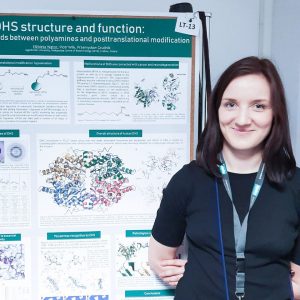During the 1st Joint Polish-German Crystallographic Meeting 2020 in Wrocław/Poland, Elżbieta Wątor presented her research DHS structure and function: On the crossroads between polyamines and posttranslational modification. For her great presentation, she received the Poster Award sponsored by STOE. Read here more about her latest research experience.
What fascinates you about structure-property-relationships?
Enzymes are fascinating nanomachines of extraordinary complexity. It is now well established that it’s their structure rather than their sequence that determines the function; and crystallography is so far the best tool that allows us to see mutual arrangement of their cogs. Also for most of us, it is easier to understand something when we can see it. By means of structural biology we can dissect the protein structure with amazing accuracy and conclude about it’s function. It is also not only curiosity driven experience as learning about protein modus operandi we can interfere with it and e.g. block activities of the rogue ones.
How did you come to crystallography?
During holidays after my Bachelor studies I participated in 29th International Summer Student Programme organized by Helmholtz Zentrum Berlin. I worked in Macromolecular Crystallography group led by Dr Manfred S. Weiss at BESSY II synchrotron. Thanks to the fantastic supervision during a relatively short time I had unique opportunity to learn all steps needed for protein structure determination… and basically fell in love with protein crystallography. Later on I had the opportunity to further broaden my knowledge and skills during an internship at the Center for Free Electron Laser Science in Hamburg and again at BESSY II in Berlin, during studies within the Erasmus+ programme. Since the beginning of 2018, I am working together with Dr. Przemysław Grudnik on unique post-translational modification: hypusination, which malfunctions are associated with such conditions as cancer or neurodegeneration – first in the context of my Master thesis and since October 2019 as a PhD student.
What is the most interesting part or fact about your work for you personally?
For me the most fascinating part of my work so far is that every day is different and you can not complain about its boredom or predictability. In protein crystallography, there is no way to predict conditions favouring crystal formation – that is making our everyday efforts also a little bit about magic? And of course this thrill of being the first person to see the electron density of a new structure for the very first time.
